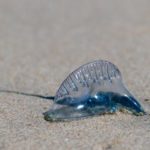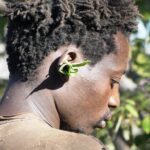When hiking in Pu Luong Nature Reserve in northern Vietnam, we found a species of Stinging Nettle Slug Caterpillar on a Banana leaf. My local friends got highly nervous when they saw it, and I was intensely warned against touching it.
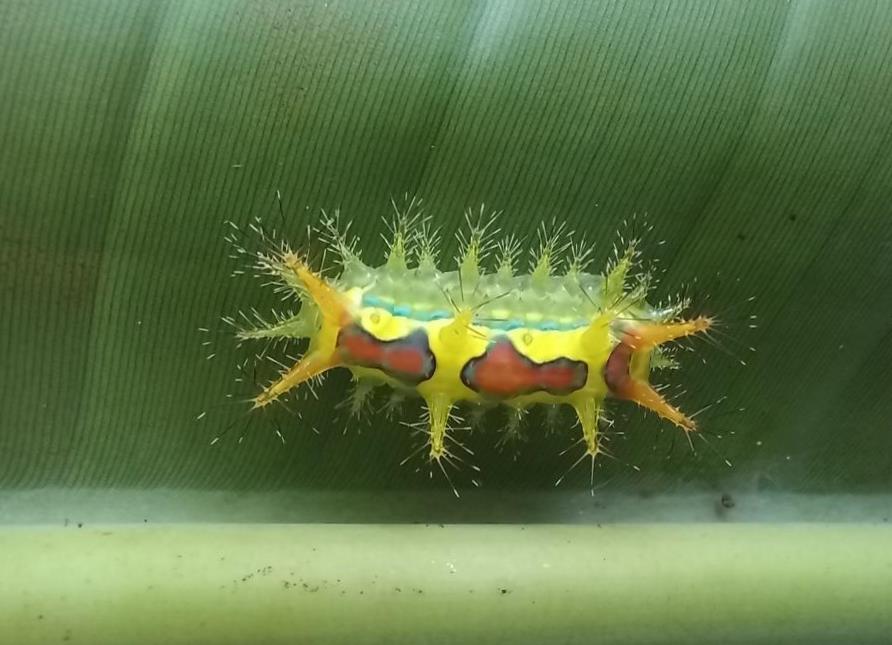
Description of specimen
Stinging nettle slug caterpillars are larvae instars of a small-sized, hairy moth that belongs to the taxonomic family of Limacodidae. Wikipedia – see here – describes them as:
‘… The larvae are often liberally covered in protective stinging hairs and are mostly tropical, but occur worldwide, with about 1800 described species and probably many more as yet undescribed species…’.
A similar specimen was found at Pu’er in China. This suggests that this species has a wide distribution area in the northeastern parts of Southeast Asia. The length of this caterpillar species was about 2 cm (3/4 inches) of body length. That length was estimated without scoli, the protuberances on both body ends. This caterpillar feeds on leaves.
The toxicity of our specimen
The exact species name of our specimen is currently unknown to the author, but reports exist about the toxins of similar species. One of them is the Saddleback Caterpillar (Acharia stimulea). Saddlebacks are capable of launching a two-pronged defense response. Its stout urticating bristles may break off to remain embedded in its assailant. Some are envenomating bristles and contain two venom types: vesicating and hemolytic. Vesicating venoms cause blistering, and hemolytic venoms will break down red blood cells. Stings from these hairs are intensely painful and are described by victims as sharp and burning. The pain may last long and often spreads over a large area.
In Thailand, the venom of the Stinging Nettle Caterpillar Parasa lepida was investigated, which can be accessed at the same link as the picture above. The researchers found 168 toxin genes and also 21 novel genes, which were similar to neurotoxins in scorpions and tarantulas. This paper further explains that Parasa lepida is one of the most harmful caterpillars to humans in Thailand, causing intense pain, burning, itching sensations, and severe dermatitis.
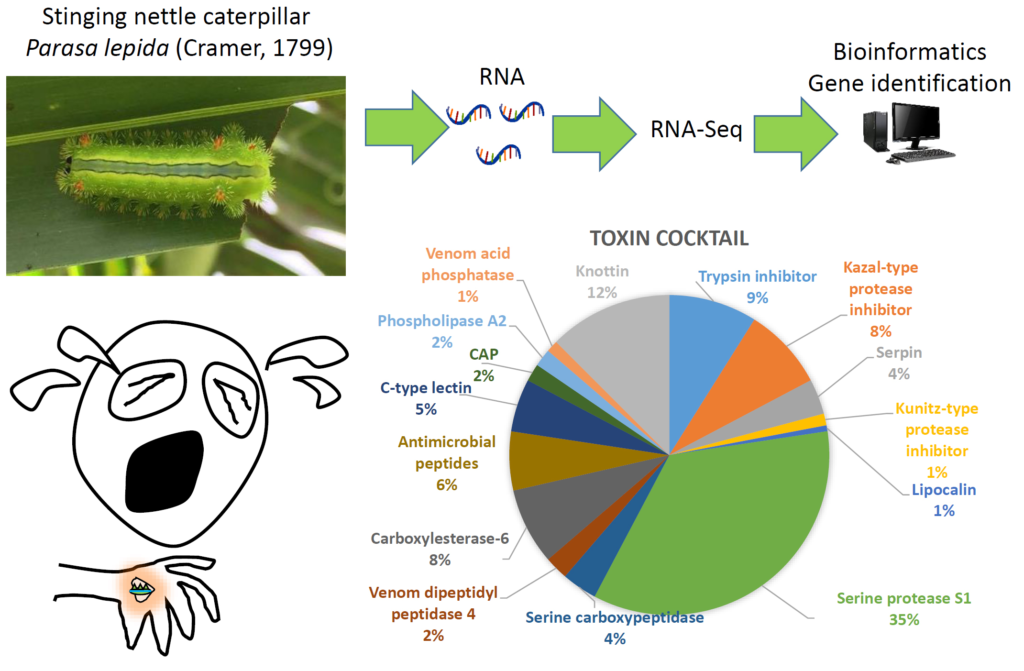
However, little is known about toxins from other genera of Limacodidae, e.g., Acharia, Adoneta, Darna, Euclea, Isa, Thosea, Phobetron, and Sibine. Therefore, the toxic effect of our specimen’s venom can’t be answered correctly at this time.
Envenomation process
There are three types of spines in caterpillar hairs:
- True Setae. These are bristles grown from the caterpillar’s epidermis without a venom sac.
- Modified Setae. Bristles are supplied by a venom sac within the epidermis of the caterpillar.
- Spines. The spine is on a bristle with a venom sac inside the spine.

Stinging Nettle Caterpillars have these spines on elongated bristles. The photo below shows that the bristle is dark on our specimen, and the spine is white.
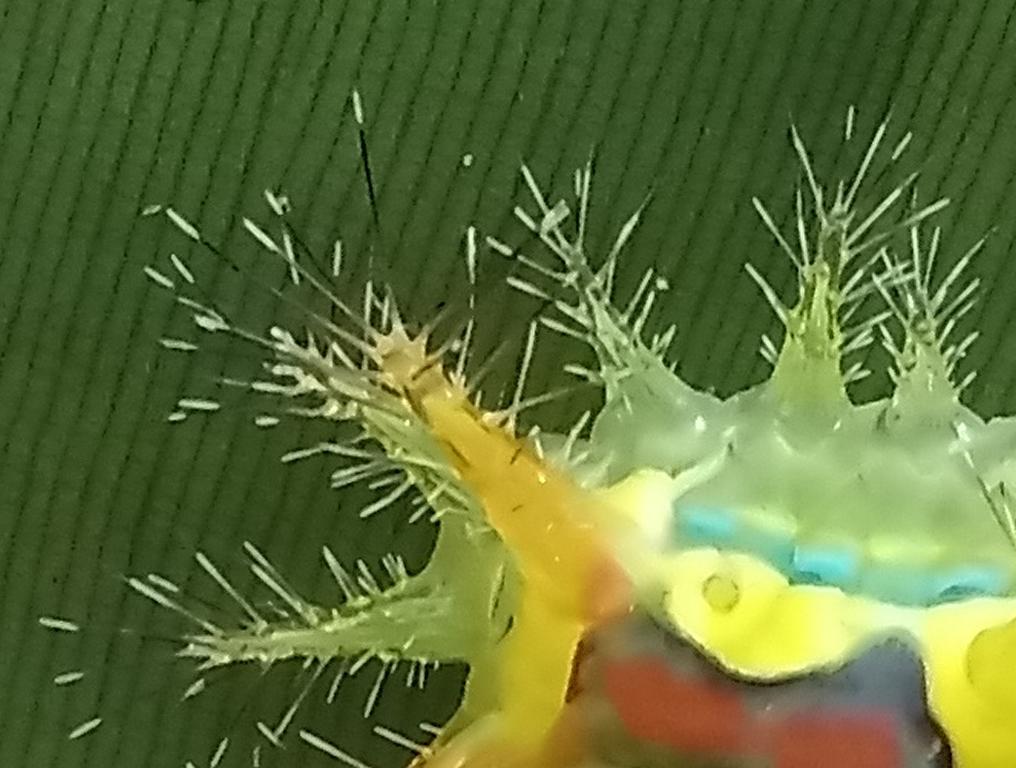
This is very similar to Saddleback Caterpillars, which appear as follows but with reverse coloration:

The envenomation process involves mechanically piercing the skin with the spine and immediately releasing the venom into the stung body. The tip of the spine will also remain in the body.
How to treat Stinging Nettle Caterpillar stings?

In an allergic reaction, professional medical attention must be sought immediately.
In non-allergic cases, the ‘Poison Control, National Capital Poison Center’ in the US – see here – recommends the following:
‘To treat a rash caused by caterpillar stings:
- If the caterpillar is on the skin, remove it without using your hands!
- Gently put tape over the exposed area, sticky side down. (Any tape will do.)
- Pull up the tape, removing the hairs or spines.
- Repeat with fresh tape as often as needed to treat the area involved.
- Wash the area gently with soap and water.
- If the area itches, put on a paste of baking soda and water.
- If that doesn’t help, try a hydrocortisone cream.
- If that doesn’t help, try an antihistamine cream. That shouldn’t be the first choice, as it doesn’t always help. Also, some people have skin reactions to these creams.
- If the area is badly blistered, contact your health provider.
- Call your health provider about a tetanus booster if your shots are not current.’
When Penang people in Borneo are stung by such a caterpillar, the victim crushes the animal’s body and drips the juice onto the painful area as medicine.
Lessons learned from Stinging Nettle Slug Caterpillars:
- Although Stinging Nettle Slug Caterpillars are quite small in size, they have a significant health effect on the stung person.
- Never touch them, but use tools to move them away to a safe area.
- There is still much research to be done to describe more species of these moths and their instars and pupae.
- Over and above that research, more scientific work is still needed to sequence the genes of their toxins.
More articles on this website about caterpillars can be found via the following links:
Edible caterpillars in D.R. Congo, Introduction
Edible caterpillars in D.R. Congo, Part 1
Edible caterpillars in D.R. Congo, Part 2
Edible caterpillars Nudaurelia sp.
Collection of edible caterpillars in D.R. Congo
Edible caterpillars for food in Congo
Green caterpillars, called ‘Kaba’
.


